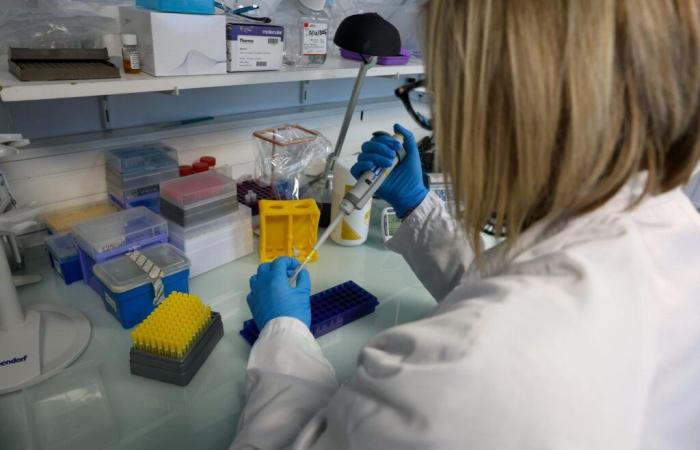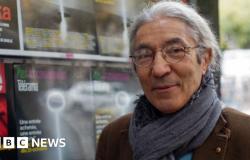Imagine, on the left of the screen, the black and white film of young Philippe and Édouard limping on their legs deformed by Duchenne muscular dystrophy. And, on the right, the color video of little Sacha, 8 years old, running up a staircase a few months after treatment received in September 2022 against this same genetic disease which causes progressive degeneration of all muscles.
These two sequences were captured by combat mothers: the first, in the mid-1970s, by Yolaine de Kepper, founder of the French association against myopathies (AFM); the second, in 2024, by Hélène, who with her husband Édouard will be one of the “ambassador families” invited to demonstrate the progress made in gene therapy during the 38e edition of the Telethon, November 29 and 30.
A simple principle, on paper
We especially hear about this medical technique and the hopes it arouses during this television marathon, intended to collect donations from the public to finance research. But what is it exactly? “On paper, the principle is simple: it’s about fighting genetic diseases using genes”begins Doctor Serge Braun, scientific director of the AFM-Téléthon.
A gene is the basic unit of the 23 pairs of chromosomes found in the nucleus of our cells and which form DNA, this double helix molecule which contains our hereditary heritage. Genes condition our physical characteristics and deliver the “code” that allows the cell to “manufacture” the proteins necessary for the body to function.
“Except that it can happen that one or more genes – out of the 21,000 in each cell – are defective following a mutation, which causes a disease. Hence the idea of providing a healthy gene which will do the work of the mutant gene”summarizes Doctor Braun. “The concept was established in the 1970s, it remained to develop the tools to implement it. It took some thirty years before the first encouraging clinical results were obtained.he continues.
Viruses like “Trojan horse”
The first challenge was to find a “vector” capable of bringing the repair gene to the patient. To do this, researchers thought about viruses, 100 to 1000 times smaller than our cells and which have the “keys” to penetrate them. “The most commonly used are lentiviruses, a family that includes AIDS, and associated adenoviruses (AAV) of the type that transmits the common cold. Virus that we have taken care, beforehand, to render harmless”specifies Serge Braun.
To introduce this “Trojan horse” into the body, several processes exist. The first consists of taking cells from the patient and then culturing them (ex vivo) in contact with the viruses which will deliver the drug gene so that it integrates into their genome. The modified cells are then reinjected into the patient. This is the technique used in the early 2000s by professors Alain Fischer, Marina Cavazzana and Salima Hacein-Bey-Abina, French pioneers of gene therapy, to treat “bubble babies” who suffered from an innate immune deficiency. .
Another way to do it is to inject directly (alive) vectors in the body. This is the treatment used successfully since 2020 against infantile spinal muscular atrophy, a rare disease which affects motor neurons and whose severe form causes death before the age of two.
Spectacular results
This same technique was used to treat young Sacha, diagnosed with Duchenne muscular dystrophy, and who is one of the five young patients included in the clinical trial launched in 2021 by the Généthon laboratory. “With this additional difficulty that it was necessary to create a shortened version of the drug gene to make it enter the virus and add a “promoter” so that it could, once delivered through the bloodstream into the muscles and the heart – in a single dose but more than a million billion copies – produce sufficient quantities of dystrophin, this protein essential to their functioning”explains Doctor Braun.
And the results are once again spectacular, as evidenced by the published data and Sacha’s regained vitality 18 months after treatment. “We take advantage of what is offered to us but we do not forget those who are still waiting”says Hélène, her mother, soberly.
A way of emphasizing that there is still so much to do. Firstly because there are more than 7,000 genetic diseases recorded to date, most often rare and whose causes and effects vary extremely, which opens up an immense field of research. Then because the therapeutic processes themselves are still to be consolidated.
When will access be available to as many people as possible?
Research into the technique known as “gene surgery” illustrates the scale of the challenges that remain to be met. “This consists, not of providing a healthy gene, but of repairing the defective gene by removing the part which corresponds to the mutation to replace it with the good sequence”explains Marina Cavazzana, professor of hematology and head of the biotherapy department at Necker hospital in Paris.
To do this, we use “molecular scissors”, a revolutionary tool developed in 2012 and which earned Frenchwoman Emmanuelle Charpentier the Nobel Prize in 2020. The problem is that early trials on blood diseases have had mixed results. “These scissors work quite well to inactivate a sequence but the exact repair of a mutation still requires improvement”specifies Professor Cavazzana.
The other big issue concerns ethics. “Given the high cost of these treatments – currently between 2 and 3 million euros per injection – the question arises of their access to the greatest number of people. Is this cost justified? If so, there will definitely be a selection. Unless pharmaceutical companies play the game, which is unlikely because their business model is based on profit.worries geneticist Patrick Gaudray, former research director at the CNRS.
“Criticism is easy but the art of innovation is difficult. To support it, there would need to be a complete change in the economic model of care by the health authorities”argues Valérie Rizzi-Puechal, director of the rare diseases unit at Pfizer. Involved in this field for thirty years, the American laboratory has developed three gene therapies: the first, without success, against Duchenne muscular dystrophy, the other two against hemophilia.
A fight that benefits all patients
“Our treatment against the so-called B form is already marketed in North America and received marketing authorization from the European Medicines Agency in July. We are awaiting the full results of the trial conducted on the treatment of hemophilia A, but the initial feedback is promising”she says.
An investment whose amount is kept secret but which could be repaid because gene therapies originally developed for rare genetic diseases can also be used, by extension, to treat more traditional pathologies: cancers, cardiovascular diseases or infections. “This is the case for half of the 40 drugs approved in recent years”underlines Doctor Serge Braun.
An argument which is among the good reasons to mobilize given by Laurence Tiennot-Herment, the president of the AFM-Téléthon. “Gene therapies work, and this fight for research benefits everyone, she assures. But to continue this great adventure started in 1987, you need resources. » Will the general public respond to this call? In 2023, the collection of donations brought in €92,905,533.
—–
The AFM-Telethon battles
1958. Foundation of the French Association for Myopathy (AFM) by Yolaine de Kepper, mother of seven children, four of whom suffer from Duchenne muscular dystrophy, and families mobilized to have neuromuscular diseases recognized.
1981. The AFM creates its first scientific council, the start of an unprecedented partnership between patients, researchers and doctors.
1986. Discovery of the gene responsible for Duchenne muscular dystrophy. The AFM places genetic research at the heart of its action.
1987. Launch, in France, of the first Telethon. The donations will finance Généthon, a laboratory dedicated to deciphering the human genome and gene therapy for rare diseases.
2000. First success of gene therapy for “bubble babies” by Professor Alain Fischer’s team with the support of the Telethon.
2024. The AFM-Téléthon financially supports 350 research programs and 40 current or future clinical trials for 33 diseases.






